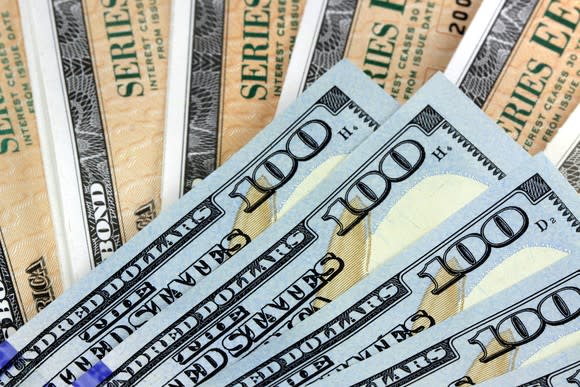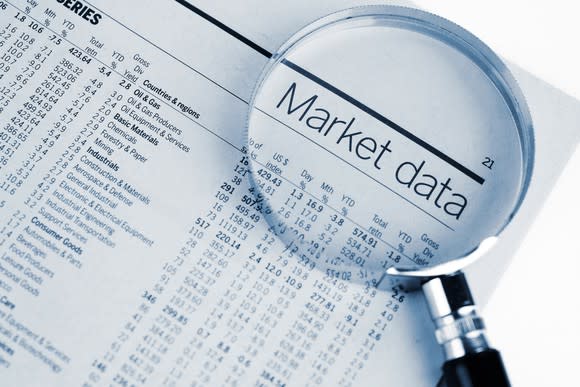A Yield Curve Inversion Would Wallop This High-Yield Dividend Industry
Following a greater-than-nine-year uptrend, the stock market genuinely appears to be faltering. In recent weeks, the broad-based S&P 500 and Nasdaq Composite have dipped into correction territory -- i.e., a decline of at least 10% from recent highs -- on more than one occasion. As of Tuesday, both indexes sat closer to being in a bear market than to hitting a fresh all-time high.
Why is the stock market tumbling?
What's to blame, you ask? Well, don't make the mistake of pointing your finger at any one thing. Rather, it's a combination of factors that has created worry on Wall Street and with short-term investors.

Image source: Getty Images.
There are obvious concerns about the lasting impact of a trade war between China and the U.S., the two largest economies in the world by gross domestic product (GDP). A persistent escalation between these two countries, or even a failure to reach a long-term agreement on tariff cessation, could hurt growth prospects for both countries.
Additionally, Wall Street and investors are wondering where the next catalyst will come from. Wall Street is always looking into the future, and it's tough to see how the GDP growth rate or unemployment picture gets any better. Historically, the unemployment rate doesn't dip below 4% for very long. Likewise, there's only so much stimulus that can be provided by the Tax Cuts and Jobs Act, which lowered corporate and individual tax liability.
Over the past month, however, perhaps no concern has been more prominent than the yield curve.
What's the yield curve and why does it matter?
The yield curve describes the interest rates of a similar debt contract over time, expressed in a chart. This curve plots out the yields on various Treasury bonds based on their maturity. Generally speaking, bonds with a shorter maturity of, say, one month or one year should have a lower yield than bonds with a maturity date of 10 years or 30 years. This would create an up-sloping yield curve, and it's often a sign of a healthy, expanding economy.
But the yield curve doesn't always look like this. Sometimes it flattens out, whereby the gap between two maturity dates shrinks considerably or becomes equal. And in rarer occasions, it'll invert. This is where short-term maturities bear a higher yield than longer-term maturities. Both instances can signal a coming recession. While an inverted yield curve doesn't by itself guarantee a recession, a yield inversion has preceded each and every recession since the Great Depression.

Image source: Getty Images.
Since February, the margin between the two-year and 10-year Treasury yield has shrunk from as much as 75 basis points to just 13 basis points last week. The yield curve is most definitely flattening.
So, why is a flattening or inverted yield curve bad? The simple answer is that it discourages banks from lending. Banks usually make money by borrowing at short-term lending rates and lending out at longer-term rates. This is why mortgages are such incredible growth drivers for banks when the economy is firing on all cylinders. If the yield curve flattens or inverts, lending no longer becomes very profitable for banks. And if lending slows down dramatically, the U.S. economy will, too.
This industry could be decked by a flattening or inverted yield curve
Interesting enough, it's not banks that could face the biggest investor backlash if the yield curve continues to flatten or invert. Rather, it's the extremely high-yield mortgage real estate investment trust industry, or mREITs.
Popular mortgage-REITs, such as Annaly Capital Management (NYSE: NLY) and AGNC Investment Corp. (NASDAQ: AGNC), primarily invest in mortgage-backed securities (MBS). The way these companies make money is by borrowing at short-term lending rates, purchasing these MBSs that have long-term yields, and pocketing the difference as net interest margin. Annaly and AGNC Investment will also use leverage to their advantage by purchasing many times their equity to boost profits. And, as REITs, they're required to pay out most of their earnings to shareholders as a dividend in order to avoid normal corporate income tax rates. That's led to an 11.9% yield for Annaly, and a 12.1% yield for AGNC.

Image source: Getty Images.
Speaking generally again, mREITs perform their best when interest rates are declining. Conversely, when lending rates are on the rise, investors tend to power walk to the exit. That's because as the Federal Reserve lifts its federal funds target rate, which in turn trickles down to impact yields, the margin between short-term and long-term lending rates shrinks. As this rate shrinks, mortgage-REITs like Annaly and AGNC Investment tend to earn less money, leading to a dividend reduction. And let's be honest, most investors buy into Annaly and AGNC Investment for their double-digit dividend yields.
Now, here's where things get interesting. Despite the Fed tightening monetary policy for the past three years, Annaly's and AGNC's operating results haven't deteriorated as quickly as Wall Street might have expected. The reason? The Fed has been orderly and calculated in its rate increases, leading to slow and predictable movements in lending rates. When rates move slow, Annaly and AGNC have the ability to adjust their portfolios and leverage to maximize profits.
Over the past month, things have changed. Long-term Treasury yields have plunged by more 30 basis points, while short-term yield are mostly flat to up a few basis points. The pace at which yields are moving is no longer orderly, which is what creates havoc for mortgage-REITs.
If the yield curve were to flatten or invert, it would not be in the least bit surprising if Annaly's and AGNC Investment's profits were to drop considerably, leading to respective dividend cuts.

Image source: Getty Images.
The could be silver lining
Now, if there is a silver lining here, it's that Annaly and AGNC Investment have already taken a beating well in advance of the yield curve flattening. Investors appear to have discounted an eventual dividend cut, with Annaly's and AGNC's respective share price being cut in half since the early part of the decade.
However, AGNC, and especially Annaly, have been through this before. Their respective management teams understand how to position their portfolios to survive what's often a relatively short-term inversion or flattening of the yield curve. Even if their respective dividends were to decline, there's a very good chance they'll be many times higher than the average yield of an S&P 500-listed stock. Over the past 20 years, Annaly has averaged about a 10% yield, which is pretty hard to top for income-seeking investors.
In other words, even with the industry facing what could be a very challenging couple of quarters if the curve continues to flatten or even inverts, history suggests that they'll eventually come roaring back.
More From The Motley Fool
Sean Williams has no position in any of the stocks mentioned. The Motley Fool has no position in any of the stocks mentioned. The Motley Fool has a disclosure policy.

 Yahoo Finance
Yahoo Finance 